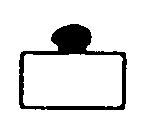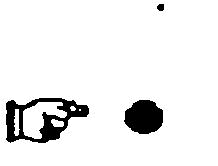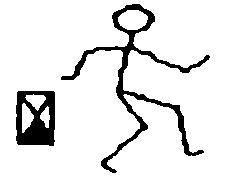Table of Contents |
Back to Homepage |
8/22/99
| What is a rebus? An example Rebus Sheet Rebus explanations |
Yellow words Red words Green words Sources for some of the rebuses |
A rebus, as used in Tailored Reading, is a simple illustration (ideally, one that might be quickly drawn from memory if none are available) of the meaning of a word that enables the pupil to learn it more easily. Rebuses are most beneficial for those who have little or no knowledge of reading and who have difficulty learning by rote. Many at-risk readers have poor memories for unmeaningful information, so providing a conceptual clue lessens the need to rely on rote memory. One of the primary aims of Tailored Reading is to raise comprehension by quickly elevating the pupil’s reading vocabulary. Using rebuses to facilitate learning of the Rainbow Words greatly aids the process as well as providing motivation and making them feel better about their abilities to learn.
As each rebus is mastered, it can be used for matching and other activities to aid the learning of the spelled word, as well as in self-testing. In effect, the rebus enables the pupil to remind himself of, or re-teach himself the word whenever such reinforcement is needed, and this need diminishes progressively as the spelled word becomes internalized.
While
the words for some of the rebuses are obvious (e.g. "dog": ![]() ), others (e.g.
"on":
), others (e.g.
"on": ![]() )
may require some discussion for the pupil to make the precise connection. The rebus for
"is" (
)
may require some discussion for the pupil to make the precise connection. The rebus for
"is" (![]() ) may take
much more reinforcement to learn, since without discussion, it doesn't bring to mind the
word "is." "Is" is a concept for which there is no obvious
illustration (how can you draw a picture of an "is?"). The dot (or ball) just
is (it exists), and requires the context of several sentences
(e.g. "A dog is in the car," "A goat is on the
train," etc.) to provide enough repetition for mastery. Cards, which can be easily
rearranged, are an excellent vehicle for this.Whether the word is obvious or not however,
it is important that each rebus is explicitly taught, since it is a specific word that is
to be learned, not a synonym or other equivalent. If allowed to guess the rebus of the
word "on" for example, the phrase "on top of" might be guessed and
remembered. Even the word "dog" might be guessed as "doggie."
) may take
much more reinforcement to learn, since without discussion, it doesn't bring to mind the
word "is." "Is" is a concept for which there is no obvious
illustration (how can you draw a picture of an "is?"). The dot (or ball) just
is (it exists), and requires the context of several sentences
(e.g. "A dog is in the car," "A goat is on the
train," etc.) to provide enough repetition for mastery. Cards, which can be easily
rearranged, are an excellent vehicle for this.Whether the word is obvious or not however,
it is important that each rebus is explicitly taught, since it is a specific word that is
to be learned, not a synonym or other equivalent. If allowed to guess the rebus of the
word "on" for example, the phrase "on top of" might be guessed and
remembered. Even the word "dog" might be guessed as "doggie."
Here's an example of how, once learned, the rebuses can be useful in reinforcing new words. Each of the words of the following sentence can be clicked on to instantly connect to its rebus, enabling the pupil to have a means to independently remind himself of a problematic word. (After the rebus appears on the screen, click on the back button to return here.)
Of course, the concept of using the rebus to reinforce the word doesn't
require a computer. Paper or cards (typical tutor tools) do very well, depending upon the
game or activity. The rebuses on the sheet can be cut out individually and pasted on the
back of a card with the word printed on the other side. On the other hand, using the uncut
Rebus Sheet can always be easily used to match words. To make it easier to match
a Rainbow Rummy word card with its
rebus, a color-coded mark (or colored letter) on top of each column facilitates finding a
word of that color. This further empowers the pupil to self-test and reinforce her
knowledge of the words.
The Rainbow Word/Rebus Association Sheet contains the Rainbow Words in the
same order as on the Inventory. Sentences can be composed by the learner by merely
selecting one word from each adjacent column (shown below with the appropriately colored
asterisk above each).
After even only a few of the rebuses of each column have been discussed and understood, the pupil is able to perform various activities that helps her learn the represented words. For example, a word chosen from each column from left to right is written in the space below or on a separate sheet of paper. This sentence can be illustrated and discussed to demonstrate that its meaning is understood. The sentence, "A boy is in the car." was composed as follows at the bottom of the following sheet:
|
Rainbow Word/Rebus Association Sheet
|
||||||
| * | * | * | * | * | * | |
| a | b | c | d | e | f | |
1. |
A |
dog |
is |
in |
the |
car. |
| 2. | My |
goat |
rides |
 on |
that |
train. |
| 3. | The |
boy |
ran |
with |
a |
cake. |
| 4. | That |
kitten |
looked |
around |
my |
fish. |
| 5. | This |
baby |
sits |
behind |
this |
pony. |
| A | boy | is | in | the | car. | |
|
It is wonderful to see a pupil enthusiastically realize that he can read and write sentences composed of known words along with new ones introduced with their rebuses, and the words can be used immediately in various activities. It is fine to let the pupil have access to a word's rebus whenever needed. Click on Rebus Sheet to have access to one which can be printed and used with a pupil.
Rebus explanations. Many of the rebuses illustrate the words clearly enough for the tutor to be able to discuss them with the pupil. Those which may need more clarification are as follows:
1. Yellow
words (determiner):
1.1. Personal possessive pronouns. These are each illustrated by a stick figure(s) holding
a suitcase, standing within parentheses. The figure who is pointing to the one who owns
the suitcase (which, of course, for the word "my" is the same individual) also
says who owns it, as indicated by a comic strip "voice balloon" above the head
of the speaker. The word said ("my," "your," "his," [the
last two are included in the second half of Rainbow Words]), depends upon the
relationship of the owner(s) of the suitcase to the speaker. For children who are weak in
language and need additional help, acting out with real people each of these yellow words
is usually helpful. The following describes the less obvious rebuses found in sentences 1
- 5:
1.1.1. My:![]() The owner of the suitcase say he owns it. He says, "It is my suitcase."
The owner of the suitcase say he owns it. He says, "It is my suitcase."
1.2. Rebuses of the other yellow words.
1.2.1. The.![]() The is represented by a hand pointing, since one often says "the" when pointing to objects.
The is represented by a hand pointing, since one often says "the" when pointing to objects.
1.2.2. That. ![]() The hand is now pointing to an object (a ball)
farther away.
The hand is now pointing to an object (a ball)
farther away.
1.2.3. This.  The hand is now pointing to ball that is close by.
The hand is now pointing to ball that is close by.
2. Red words (verbs).
2.1. Is.![]() The ball represents "is" by just being there. The ball is. When discussing rebuses with the
pupil it is a good idea to place the new word in the sentence, such as, "The dog is
in the car." In sentence #1 the word "in":
The ball represents "is" by just being there. The ball is. When discussing rebuses with the
pupil it is a good idea to place the new word in the sentence, such as, "The dog is
in the car." In sentence #1 the word "in": ![]() can
reinforce "is" because the ball is then in the box.
can
reinforce "is" because the ball is then in the box.
2.2. Rides. ![]() The boy rides in the wagon.
The boy rides in the wagon.
2.3. Ran.  The little hourglass with the sand on the bottom next to the stick figure,
tells that the action has already taken place. It would be a good idea to show an
unfamiliar pupil a real hourglass or egg timer. This is true for two of the five red words
in sentences 1 - 5, and should be used to remind the pupil that the "doing" has
been "done" for that word.
The little hourglass with the sand on the bottom next to the stick figure,
tells that the action has already taken place. It would be a good idea to show an
unfamiliar pupil a real hourglass or egg timer. This is true for two of the five red words
in sentences 1 - 5, and should be used to remind the pupil that the "doing" has
been "done" for that word.
3. Green words
(prepositions).
3.1. With.![]() The links of chain are with each other.
The links of chain are with each other.
3.2. Around. ![]() The arrows point around the
ball.
The arrows point around the
ball.
3.3. Behind. ![]() The black box is behind the
white box.
The black box is behind the
white box.
By playing games such as Rainbow Rummy and Memory, as well as involvement in other activities, with the Rebus Sheet easily accessible if needed, the pupil should not have too much difficulty learning the words. It is wonderful to see a pupil enthusiastically realize that despite her problems in the past, she truly is learning and that it will continue.
Source for some of the rebuses. The idea for using rebuses as teaching aids began before the Rainbow Words became finalized. Trying to keep some degree of standardization rather than being totally original, a number of the rebuses of the Peabody Rebus Reading Program and more specifically, the Standard Rebus Glossary, written by Charlotte R. Clark, Cornelia Oakes Davies, and Richard W. Woodcock, published by American Guidance Service, Inc. in 1974, were used.